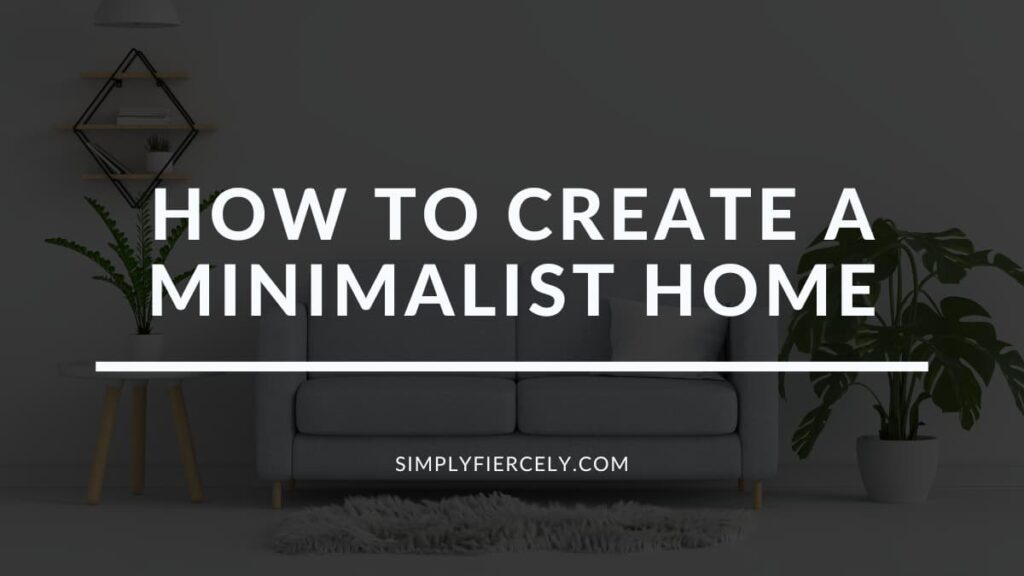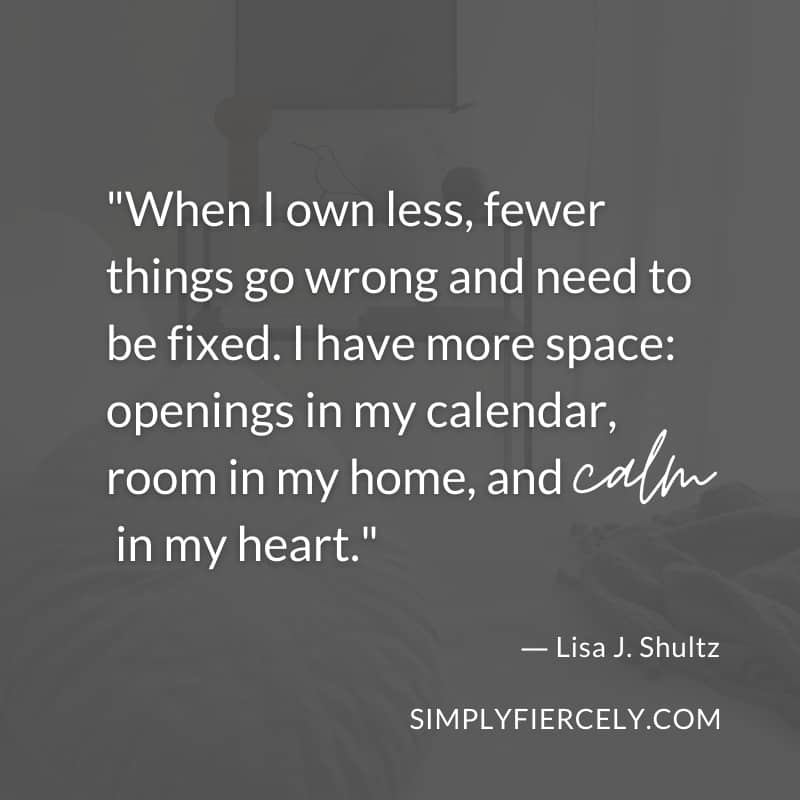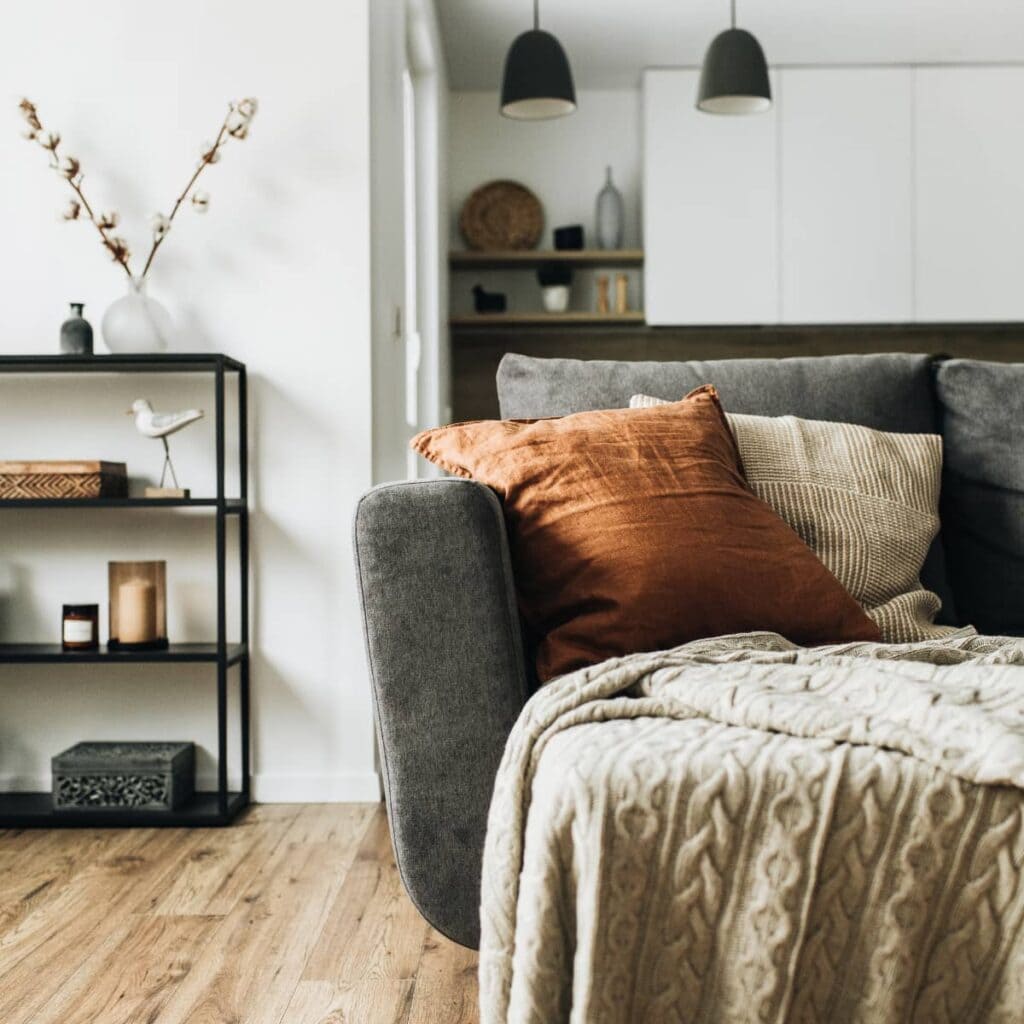While researching this blog post, I typed minimalist home into Google just to see what would show up. The results? A flood of images with white walls, hardwood floors, and chic “scandi” style furniture.
The living spaces I saw were beautiful—sleek, modern and bare—but I feel called to point out that the minimalist design aesthetic is not the same as the minimalist lifestyle. Embracing simplicity in your home doe sn’t mean you have to forgo bright colours, abandon your style, or give up all your favourite things.
Instead, I invite you to consider a different definition of a minimalist home: a space that feels just right for you and your family. It’s not too cluttered or too bare. The colour palette, furniture, and style still represent you, but in a way that’s just enough.
In the words of Peter Walsh, the author and professional organiser: “Your home should be the antidote to stress, not the cause.” I take this to heart. There are no rules you must follow, but in a minimalist home, there is space to breathe and room to love. Here are some tips that will help you get started.

- Reasons to Embrace a Minimalist Home
- How Can I Make My Home More Minimalist?
- 10 Simple Tips For A Minimalist Home
- 1. Consider how much you want to clean and maintain
- 2. Be intentional about leaving white space
- 3. Declutter—starting with your pain points
- 4. Try clutter-free home decor
- 5. Question your “just in case items”
- 6. Pause before you replace things
- 7. Keep relaxation zones clutter-free
- 8. Rethink your furniture
- 9. Curate your collections
- 10. Create a system for managing paper clutter
- And finally … regularly audit your home
- Learn More About Minimalist Living
Reasons to Embrace a Minimalist Home
Before we dive in, I think it might be helpful to recap some of the key benefits of creating a minimalist home. Simplifying can be hard work at first, but knowing your “why” will help you stay motivated.
- A minimalist house is a clean house. Of course, this isn’t to say that my home is never messy! But when you have less stuff, it’s so much easier to clean (here is an example of my minimalist cleaning routine as proof!).
- It’s easier to do the things you want to do. For example, if you have a minimalist kitchen, it’s easier to cook dinner because you can find what you need, you’re not shuffling piles in the middle of food prep, etc.
- You can find what you’re looking for. In the United States, the average person spends 2.5 days per year looking for lost items, “collectively costing households $2.7 billion annually in replacement costs” (source). How would you like that time and money back?
- Decluttering can increase the value of your home. And it makes sense, right? Potential buyers want to imagine themselves living in your home, and if every room of your home is packed with stuff … well, it’s not going to be very appealing.
How Can I Make My Home More Minimalist?
If you’re ready to begin, the first thing you should do is think about your goals.
Yes, I know you want to simplify (obviously!) but why? In addition to the above benefits, what does a minimalist family home look like for you? How can your home serve you? What’s important to you, and what do you need from your home?
Here are a few things on my list:
- Space to play—for kids and adults! I want to do yoga on the floor, build giant towers out of building blocks, and throw impromptu dance parties in my kitchen.
- Easy to maintain. I am not a naturally tidy person, and I don’t enjoy cleaning. I need a low-maintenance home that requires minimal upkeep.
- Room to rest and relax. I am an introvert, and I like to spend a lot of time at home. I need a quiet, comfortable holistic space where I can recharge my batteries.
- A balance between beauty and function. Like most people, I want my house to look beautiful, but I also need it to work for my lifestyle. I have two small kids, and I work from home, so things need to flow as smoothly as possible.
I highly encourage you to write your own list before you start any decluttering or organising. When you have a vision of what you want to achieve, it creates clarity, focus and purpose. This makes it easier to identify and clear the clutter from your home, and it’s motivating too!
You’re not forcing yourself to give things up or to live with the bare essentials. Instead, you’re curating your home to reflect your values and priorities—and trust me, when you approach it this way, you’re more likely to get results that stand the test of time. It’s more than an aesthetic; it’s a minimalist house that feels like home.
Also, I know it’s easy to get caught up with perfectionism, but remember that the goal of minimalism isn’t to live with as few things as possible. Real life minimalist style doesn’t look like what you see in the magazines, at least not in my house, because people live here, and we all have personal items that we love and enjoy.
We’re not interior designers or Instagram models; instead, we’re just a regular family looking for a different way of life with fewer things and space to live. And if that’s what you want too, keep reading for 10 tips that will help you create a minimalist space that reflects your unique needs and desires.

10 Simple Tips For A Minimalist Home
1. Consider how much you want to clean and maintain
When you’re decluttering a space, consider how much time and energy (and sometimes even money) you’re willing to devote to cleaning and maintenance. Then use this answer to inform how much stuff is “enough”.
For example, I know that I don’t want to spend longer than 15 minutes picking up toys on any given day. If it takes me longer, then I know we have too many and need to declutter. It’s a simple rule, but it makes my life easier because I know my limits.
Related Post: A Helpful Guide to Minimalism With Kids
2. Be intentional about leaving white space
Most people are compelled to fill the empty space in their homes, but I encourage you to experiment with clear surfaces, bare walls, and uncluttered floors. Sit with the space for a while and see how it feels. Do the clean lines create feelings of lightness and ease?
Tip: Try starting with one large flat surface, such as your kitchen island, the dining room table or even the front of your fridge! Allow yourself to experiment and find what works for you.
3. Declutter—starting with your pain points
I know that decluttering can feel overwhelming, so there’s no need to rush or take on too much at once. Instead, I recommend you start with your pain points because it will make your life easier and therefore create momentum.
For example, if the hall closet that you use every day is causing you stress because you can never find what you need, start there. The closet in the guest bedroom can wait.
Tip: Once you’ve narrowed down a starting point, these decluttering checklists can help you identify some quick wins.
Related Post: Where to Start Decluttering Your Home (5 Quick + Easy Ideas)
Ready to take on bigger decluttering projects? My free decluttering guide, Mindful Decluttering, explains the exact process I used to clear more than 80% of my belongings. There are step-by-step instructions, plus a troubleshooting guide to help you overcome your biggest challenges.
To get your free copy, simply subscribe using the form below. As a bonus, you’ll also get my regular newsletter with special offers, tips, and inspiration for simple living. (But don’t worry, you can unsubscribe anytime and still keep your free guide.)
4. Try clutter-free home decor
A minimalist home doesn’t have to be neutral or bare. You can—and should—decorate your home in a way that reflects your personal style. One way to do this is with clutter-free home decor.
Some examples include:
- painting the walls – Most people associate bare white walls with minimalist decor, but I think experimenting with colour is a great way to add personality while still embracing clutter-free living. Have fun with it! Embrace bold, solid colours or geometric shapes, whatever reflects your design style.
- swapping out light fixtures – Updating light fixtures, changing your curtains or swapping other types of hardware (like door knobs) are simple ways to make a space feel fresh and new without weighing your space down with more stuff.
- use fresh flowers, fruit, or plants – As someone who lives in a small house (660 square feet with a husband and two kids!), this is a tip I use all the time in my own home. I only have a few flat surfaces—some of which stay bare—but the others are covered with my favourite plants. It adds a lot of different textures to an otherwise boring room without feeling cluttered.
- cosy blankets or throw pillows – I love feeling comfortable (remember my vision for my home?), so blankets and pillows are useful items that double as decor. They’re also great for my kids because they encourage imaginative play without adding more toys.
Remember, anything that you use and enjoy is not clutter!
5. Question your “just in case items”
You probably have many things that you keep in your home “just in case,” and that’s not always a bad thing. Minimalism doesn’t mean being wasteful or ill-prepared.
Having said that, if you want to keep things because you might need them in the future, there are two things you should consider:
- What would I use this for? If you can’t be specific about why you might need this item in the future, then the odds are you can live without it.
- Where exactly does this live? If you know the purpose, it should be easy to give the item a specific home. For example, I keep spare ribbons for children’s craft projects, so they live in my craft box—not in a random drawer or box.
Your “someday” items must have a specific home because if not, you’ll never find them when you actually need them! This is a common mistake, and it’s why we end up with random duplicates (batteries, super glue, notebooks, etc.) around the house.
Tip: If you genuinely want to maintain a minimalist home, everything you own should have a specific place where it’s kept. And if you’re not sure where to put something? It’s probably a sign to let go.
6. Pause before you replace things
Next time you run out of something, or something breaks, pause before you replace it. This is one of the best ways to “declutter” without actually decluttering!
All you have to do is practice going without for a while. Did you miss whatever it was, or did you get by just fine without it? The answer might surprise you.

7. Keep relaxation zones clutter-free
Where do you go to relax? Your bedroom? A favourite chair by the window? Under a cosy blanket on your sofa? Elevate these spaces to true sanctuaries by keeping them clutter-free.
A great place to start is with your bedside table. Don’t use this sacred space as a dumping ground. After all, you don’t want to wake up to clutter (and the unmade decisions it often represents). Instead, clear everything away but a glass of water, a favourite book and perhaps a photo or cheerful plant.
Tip: If this doesn’t resonate with you, go back to your vision for your home. What are your goals, and how can your home help you achieve them?
8. Rethink your furniture
As I mentioned, we live in a very small space, and one of the mistakes I made when we first moved in was thinking that “everyone” owns certain types of furniture.
But … do they?
Not long after my daughter was born, we ended up giving away our coffee table and dining table. We have a large kitchen island, so it makes sense to eat there instead of wasting valuable floor space. As for the coffee table, we actually never miss it (our sofa is very low and it’s easy enough to put things on the floor).
Of course, I’m not suggesting that everyone should give up these things! But I do encourage you to think outside the box about what you really need. Also, look for functional furniture that can serve multiple purposes.
9. Curate your collections
Often our homes are filled with things that we collect, like coffee mugs, vintage records, or postcards from our travels. These are the little things that can make a house feel like a home, but your special items will have more meaning if you curate your collection.
Try stepping back and looking at your items individually. Sometimes things appear more valuable when grouped together, but when separated from the collection, they lose their appeal.
10. Create a system for managing paper clutter
Do you struggle with paper clutter like receipts and pamphlets? If so, you need a simple system to keep it under control.
The key is to avoid overcomplicating things. If it’s too hard to follow, you’ll procrastinate, and nothing will get done. Instead, handle your paper clutter right away, as soon as it enters your house.
Personally, I found that 90% of what I receive can go straight into recycling (although you may want to shred some items first). I scan most of the remaining 10% using a simple app on my phone (I use the native Notes app that comes with my iPhone, but there are lots of options). Then I store the handful of hard copies that I genuinely need to archive in a file folder.
I also regularly back up my digital copies to the cloud (using Dropbox) and to an external hard drive—and that’s it!
Tip: One thing that helps is not keeping information that can be easily found online (with a few exceptions). Things like takeaway menus, phone numbers, recipes, etc., don’t need to take up space in your home.
And finally … regularly audit your home
Here is a bonus tip for you.
The things in your home should support your lifestyle, but keep in mind that your lifestyle will change over time. Something that was once genuinely useful may eventually become clutter, and that’s OK. Just make sure that you stay on top of things by regularly auditing your life and not clinging to things that no longer serve you.
And if you get stuck, remember this helpful quote from Francine Jay: “Your Home Is Living Space, Not Storage Space.”
Learn More About Minimalist Living
If you’re looking to learn more about inviting minimalism into your life, here are some blog posts that you might enjoy:
- How to Live A Minimalist Life (A Complete Blueprint)
- My Minimalist Daily Routine: Embracing Slow + Simple Every Day
- 6 Powerful But Unexpected Minimalist Lifestyle Tips
Alternatively, you might like to read more about my minimalist journey (as a reformed shopaholic!) and how it changed my life.
Have you considered making your home more minimalist? Or do you have any minimalist home tips to share? Let us know in the comments!


Hi!
I’m new to your blog and I would love to get a free copy of your Mindful Decluttering workbook and I’ve been looking everywhere on your blog but I can’t find a form to fill in nor a link? I tried to sign up for your course page, but I still can’t find it. Please do tell me if I’m looking in the wrong place, haha! 🙂
Hi Indiana! I think that certain browsers block the form for some reason because there’s actually a sign-up box right above this comment 😊 But I have your email from your comment so I’ll send you a copy! Thanks for reading 🙂